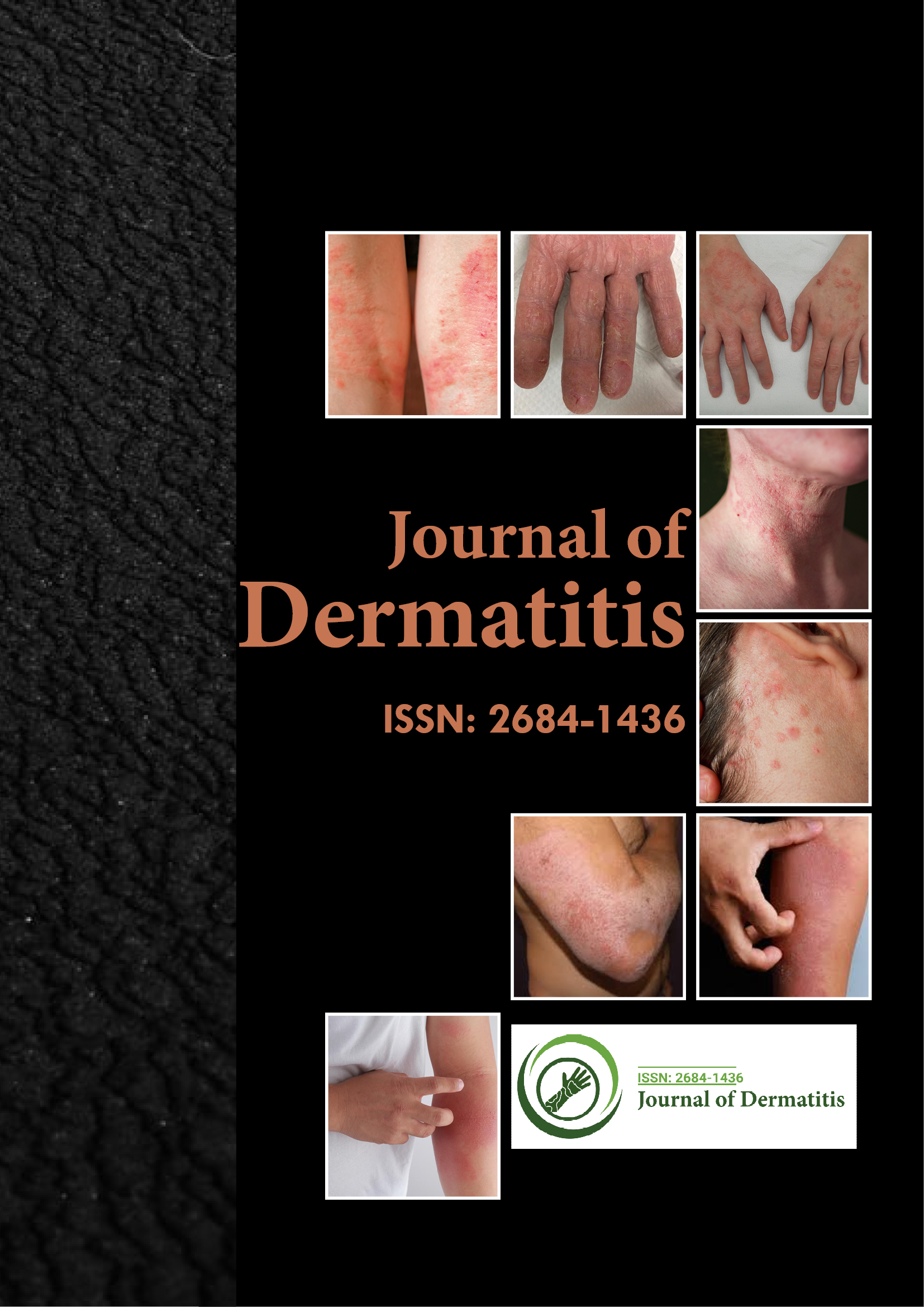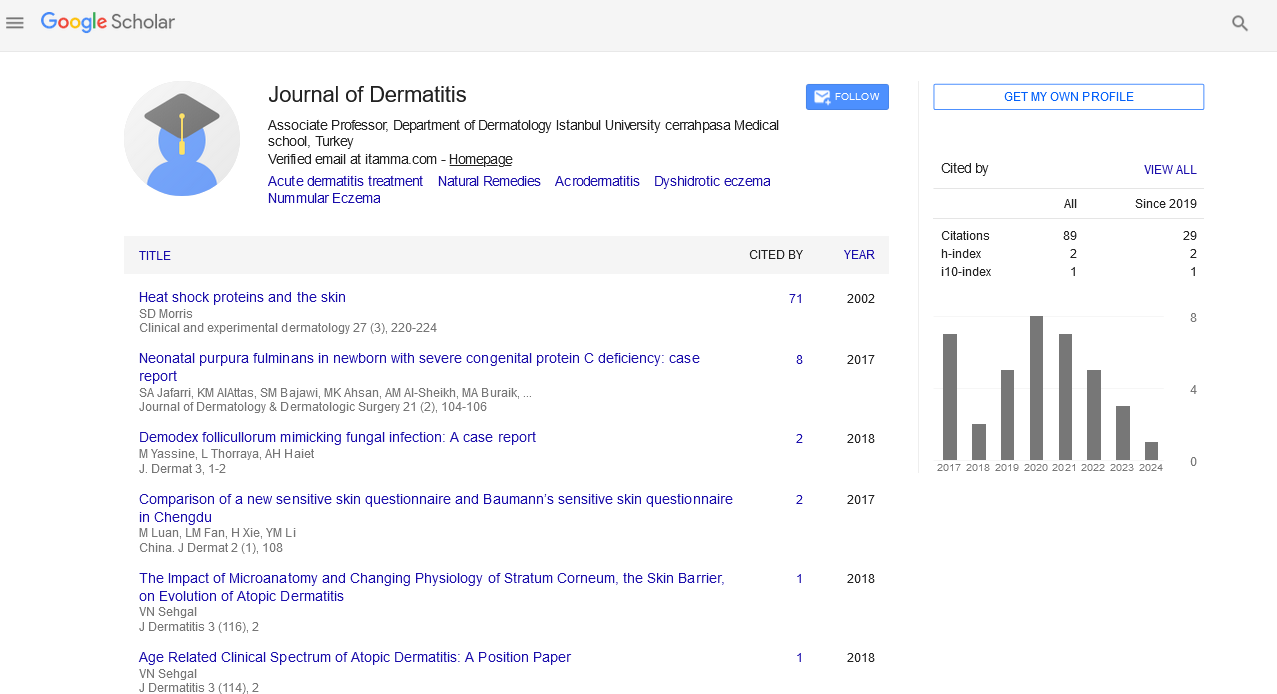Indexed In
- RefSeek
- Hamdard University
- EBSCO A-Z
- Euro Pub
- Google Scholar
Useful Links
Share This Page
Journal Flyer

Open Access Journals
- Agri and Aquaculture
- Biochemistry
- Bioinformatics & Systems Biology
- Business & Management
- Chemistry
- Clinical Sciences
- Engineering
- Food & Nutrition
- General Science
- Genetics & Molecular Biology
- Immunology & Microbiology
- Medical Sciences
- Neuroscience & Psychology
- Nursing & Health Care
- Pharmaceutical Sciences
Opinion Article - (2023) Volume 8, Issue 2
The Influence of Genetic Factors and Skin Protein Levels on Skin Inflammation
Ruben Jakson*Received: 01-Mar-2023, Manuscript No. JOD-23-20849; Editor assigned: 03-Mar-2023, Pre QC No. JOD-23-20849 (PQ); Reviewed: 20-Mar-2023, QC No. JOD-23-20849; Revised: 27-Mar-2023, Manuscript No. JOD-23-20849 (R); Published: 03-Apr-2023, DOI: 10.35248/2684-1436.23.8.188
Description
Dermatitis is a general term that refers to inflammation of the skin. It can cause symptoms such as itching, redness, dryness, scaling, cracking and blistering. There are different types of dermatitis, such as Atopic Dermatitis (AD), contact dermatitis, seborrheic dermatitis and nummular dermatitis. Each type has different causes, triggers and treatments. One of the factors that influences the development and severity of dermatitis is genetics. Genetics refers to the inherited traits that are passed down from parents to children through DNA. Some genes can affect how the skin functions and responds to environmental factors, such as allergens, irritants, microbes and temperature.
One of the most important genes that affect skin function is the Filaggrin Gene (FLG). Filaggrin is a protein that helps maintain the skin barrier, which is the outermost layer of the skin that protects it from water loss and foreign substances. Filaggrin also helps break down keratin, which is another protein that forms the structure of the skin cells. People who have mutations or variations in the FLG gene have reduced or absent levels of filaggrin in their skin. This leads to a defective skin barrier that allows allergens to enter the skin and interact with immune cells to cause inflammation1. It also leads to dry and scaly skin that is more prone to cracking and infection.
Studies have found that FLG mutations are the strongest known genetic risk factor for atopic dermatitis, which is a chronic type of dermatitis that usually begins in childhood and is associated with allergies, asthma and hay fever. About 10% to 15% of people with AD have FLG mutations. However, not everyone with FLG mutations develops AD, and not everyone with AD has FLG mutations. This suggests that other genetic and environmental factors are also involved. Besides FLG, researchers have identified more than 30 other genetic loci that are linked to AD across different populations. These genes are involved in various aspects of skin biology and immunity, such as keratinocyte differentiation, lipid metabolism, cytokine signaling, mast cell activation and microbiome composition. Some of these genes may also affect other types of dermatitis, such as contact dermatitis or seborrheic dermatitis. The discovery of these genes has provided new insights into the pathogenesis and treatment of dermatitis. For example, dupilumab is a biologic drug that binds to the IL-4 receptor alpha and inhibits downstream signaling induced by IL-4 and IL-13, which are cytokines that promote Th2-dominated inflammation in AD4. Dupilumab has been shown to be effective in reducing AD symptoms and improving quality of life in patients who do not respond well to conventional therapies.
Genetics plays a significant role in determining the susceptibility and severity of dermatitis. Mutations or variations in genes that affect skin barrier function and immune response can lead to impaired skin protection and increased inflammation. However, genetics is not the only factor that influences dermatitis. Environmental factors, such as allergens, irritants, microbes and lifestyle choices can also trigger or worsen dermatitis symptoms. Therefore, a holistic approach that considers both genetic and environmental factors is needed for the prevention and management of dermatitis.
Citation: Jakson R (2023) The influence of Genetic Factors and Skin Protein Levels on Skin Inflammation. J Dermatitis.8:188.
Copyright: © 2023 Jakson R. This is an open-access article distributed under the terms of the Creative Commons Attribution License, which permits unrestricted use, distribution, and reproduction in any medium, provided the original author and source are credited.

